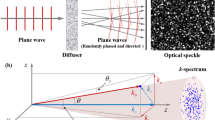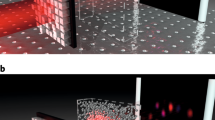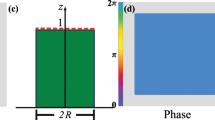Abstract
Aoderson1 and Mott2 showed that scattering from a strongly disordered system qualitatively changes the way in which electron waves propagate. It has recently been realized that these changes occur universally for all waves, in particular optical waves3–5. It is also becoming apparent that many important new phenomena previously inferred indirectly for electrons can now be observed directly for photons. Here, we show how the time evolution of the scattered wave due to inelastic phase breaking (dephasing) processes can be followed directly. When coherent light is scattered by a disordered system an image of the emergent wave is obtained in the form of an apparently random intensity alternation known as speckle. From the time evolution of this speckle pattern we have found that multiple scattering greatly reduces the time required for phase breaking. This unexpected result is explained in terms of the extreme fragility of the phases of long trajectories, and appears to have important implications for a wide variety of phenomena.
This is a preview of subscription content, access via your institution
Access options
Subscribe to this journal
Receive 51 print issues and online access
$199.00 per year
only $3.90 per issue
Buy this article
- Purchase on Springer Link
- Instant access to full article PDF
Prices may be subject to local taxes which are calculated during checkout
Similar content being viewed by others
References
Anderson, P. W. Phys. Rev. 109, 1492–1505 (1958).
Mott, N. F. Metal Insulator Transitions (Taylor & Francis, London, 1974).
Anderson, P. W. Phil. Mag. B52, 505–509 (1985).
John, S. Phys. Rev. Lett. 53, 2169–2172 (1984).
Golubentsev, A. A. JETP 59, 26–32 (1984).
Abrahams, E., Anderson, P. W., Licciardelo, D. C. & Ramakrishnan, T. V. Phys. Rev. Lett. 42, 673–676 (1979).
Gorkov, L. P., Larkin, A. F. & Khmel'nitsky, O. E. JETP Lett. 30, 228–232 (1979).
Bergmann, G. Phys. Rep. 107, 1–58 (1984).
Lee, P. A. & Ramakrishnan, T. V. Rev. mod. Phys. 57, 287–337 (1985).
Mott, N. F. & Kaveh, M. Adv. Phys. 34, 329–401 (1985).
Thouless, D. J. Phys. Rev. Lett. 39, 1167–1169 (1977).
Altshuler, B. L., Aronov, A. G. & Khmelnitsky, D. E. Solid St. Commun. 39, 619–623 (1981).
Mott, N. F. & Kaveh, M. Phil. Mag. B52, 177–183 (1985).
Schumacher, R. T. Am. J. Phys. 54, 137–141 (1986).
Etemad, S., Thompson, R. & Andrejco, M. J. Phys. Rev. Lett. 57, 575–578 (1986).
Kaveh, M., Rosenbluh, M., Edrei, I. & Freund, I. Phys. Rev. Lett. 57, 2049–2052 (1985).
Shapiro, B. Phys. Rev. Lett. 57, 2168–2171 (1986).
Kuga, Y. & Ishimaru, A. J. opt. Soc. Am. A1, 831–835 (1984).
Tsang, L. & Ishimaru, A. J. opt. Soc. Am. A2, 2187–2193 (1985).
Van Alba, M. P. & Lagendijk, A. Phys. Rev. Lett. 55, 2692–2695 (1985).
Wolf, P. E. & Maret, G. Phys. Rev. Lett. 55, 2696–2699 (1985).
Lee, P. A. & Stone, A. D. Phys. Rev. Lett. 55, 1622–1625 (1985).
Pepper, M. Contemp. Phys. 26, 257–293 (1985).
Kaveh, M. Phil. Mag. B52, 521–540 (1985).
Imry, Y. in Directions in Condensed Matter Physics (eds Grinstein, G. & Mazenko, E.) 275–293 (World Scientific, Singapore, 1986).
Author information
Authors and Affiliations
Rights and permissions
About this article
Cite this article
Kaveh, M., Rosenbluh, M. & Freund, I. Speckle patterns permit direct observation of phase breaking. Nature 326, 778–780 (1987). https://doi.org/10.1038/326778a0
Received:
Accepted:
Published:
Issue Date:
DOI: https://doi.org/10.1038/326778a0
Comments
By submitting a comment you agree to abide by our Terms and Community Guidelines. If you find something abusive or that does not comply with our terms or guidelines please flag it as inappropriate.



